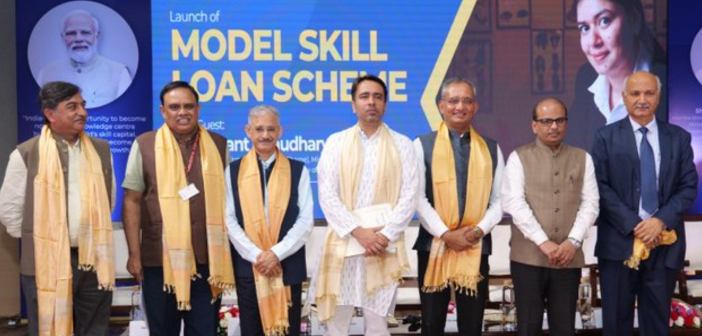There has always been a sharp schism between the skills and jobs in rural and urban India, but perhaps the post-Covid -19 scenario gives us a chance to correct several wrongs and balance as much as possible and aim towards a new normal.
The influx back to villages has been huge and continues to grow every day. Lakhs of migrants are going back to their native places often with a resolve of not coming back. This year in May, the number of registrations for MNERGA are up by 40-50% compared to last year indicating the significant jump in people requiring livelihood support in rural parts. But MNERGA can take care partly and in the short-term, in the long term there has to be more sustainable ways of providing livelihoods to this population.
Can entrepreneurship be the only answer? Could have been if the number was small but with this number small scale entrepreneurship would quickly fail due to both absence of market and lack of product/service diversity.
Check future migration – create innovative rural livelihoods
In rural India, where lot of migrant workers are going back, the challenge as well as the opportunity is to generate sustainable livelihoods which will also mean that they stay back – good for over-crowded cities and for their own families in the village. For rural areas, while entrepreneurship first comes to the mind but will there be so many entrepreneurial opportunities, how many electricians or tailors or small kirana shop can a village sustain? Even in the current Indian scenario, most of the small entrepreneurs are ‘forced’ entrepreneurs and barely manage a ‘survival return’ from their enterprise. It should not become the same agri/poor Indian farmer story where small land holdings lead to very small earnings and the cycle continues. Hence even for entrepreneurship, there have to be new types of enterprises created and not the conventional ones where the same pie gets further distributed among more competitors.
How CSC (Common Service Centres) can help post-Covid 19 situation
Recently government announced that it is looking at CSC (Common Service Centres) to become suppliers of various goods to villages through online orders. This will create a whole value chain with both jobs and entrepreneurs created to service it.
There are currently only 20,000 CSCs but India has more than 6 lakh villages, thus about 1 CSC for 30 villages. This number can easily become 1 CSC for 10 villages and each CSC will have front and back end connections for supply and demand.
A CSC can also attach to itself a warehouse which acts like a supply node for all 10 villages and for further linkages to towns and cities for surplus goods. It can also provide various other services and be a futuristic model of what ITC’s e-chaupals were in the 90s. Providing information and services to farmers on market to drone services to soil testing could all become part of CSCs menu.
Take water where the horses are
But more important than creating these novel enterprises (which perhaps will be few and far in-between) will be to work on taking industries to new pastures. While we have seen multiple announcements on Government vying foreign companies based in China to shift to India and state govts are already offering sops to them, why are we not giving incentives to current factories to shift to hinterland – go where the people are. Recently an example of a German footwear company shifting base from China to Agra in UP came to the news and if more of that can happen it will be god-sent! But it looks like more factories are shifting base to Indonesia and Vietnam than to India from China.
 Food processing is one of the least developed but potential areas for India. With India being among the highest producing list of many food grains to fruits and fisheries, this is one sector where the industries will see the advantage of setting up in hinterland. Farmers, animal husbandry and fisheries will benefit the most in terms of better rates for their produce as well as low wastage in case of high yields. Large scale sustainable and decent wage employment is also what can keep the migrants to their native places, otherwise by next year most of them will be migrating back to cities – dashing hopes of a ‘new normal’ ! Up-skilling for migrants for these shop floor skills or value-added production will help a lot to keep the migration in check.
Food processing is one of the least developed but potential areas for India. With India being among the highest producing list of many food grains to fruits and fisheries, this is one sector where the industries will see the advantage of setting up in hinterland. Farmers, animal husbandry and fisheries will benefit the most in terms of better rates for their produce as well as low wastage in case of high yields. Large scale sustainable and decent wage employment is also what can keep the migrants to their native places, otherwise by next year most of them will be migrating back to cities – dashing hopes of a ‘new normal’ ! Up-skilling for migrants for these shop floor skills or value-added production will help a lot to keep the migration in check.
Related article: Skilling in the time of Coronavirus – Read more: https://nationalskillsnetwork.in/skilling-in-the-time-of-coronavirus/
Managing post-Covid-19 crisis: Bridging gender imbalance in workforce in urban India can fill migrant vacant jobs
Urban India, on the other hand will face a sudden shortage of labour – from construction workers to housekeeping to delivery agents. This is a good opportunity to get lot of female workforce back into paid work. In urban India, the ‘female labour force participation’ has had a decadal fall from 36.7 per cent in 2005 to 26 per cent in 2018, primarily due to lack of systems and places to take care of maternal responsibilities.
For this to happen, one whole huge employment opportunity will automatically be creating affordable but safe and good quality creches, and this itself will need lot of female workforce. But lot of urban jobs of delivery agents to housekeeping to technical ones can be easily taken up by female workers with little supplementation of skills. Higher family earnings in the cities will boost economy requiring more production and supply.
This is also important as many of the companies will be into salary cuts for their current employees but those who need workers may be ready to hire at the same or higher wage than before.
According to a report by online career platform JobsForHer, work from home jobs posted in its portal saw a 30% rise in March 2020 than for the same period last year. The rise was particularly sharper in metro cities like Delhi-NCR, Bengaluru, Chennai, Mumbai, Hyderabad and Pune. Hence, more companies are looking for women workforce as well as more women are showing interest to work from home environment
Further, one of the technology fields that was among the few which witnessed growth during this period and will continue to do is AI (Artificial Intelligence). This is due to the prediction needed in highly volatile environments of a pandemic and thereon, where AI can play a major role. And all industry experts believe that this field ought to have more women to remove some of its current biases and predict more soundly. Thus women will continued to be in more demand in this field.
Under blue-collared jobs, another opportunity will be to multi-skill the workers, thus one technician will take care of the plumbing, electrical and air-conditioning – less people but higher wages. The gig economy was already catching on before Covid, but the gig workers will also need lot of new and multifarious skills to thrive in post –covid world.
While some of the above might be market driven but a joint push by all stakeholders – industry, governments, workers, etc. will give make it happen swiftly and sustainably.
Let this ‘virus’ change the world – for better this time!












